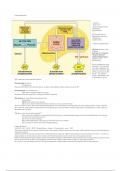Interview
Cellular Respiration
- Course
- Biology
- Institution
- 12th Grade
- Glycolysis - Krebs Cycle - Electron Transport Chain and Oxidative Phosphorylation ATP is produced by two different types of processes - Substate level phosphorylation - Oxidative phosphorylation Glycolysis takes place in the Cytoplasm. Kreb cycle and the Electron Transport Chain and Oxidati...
[Show more]



